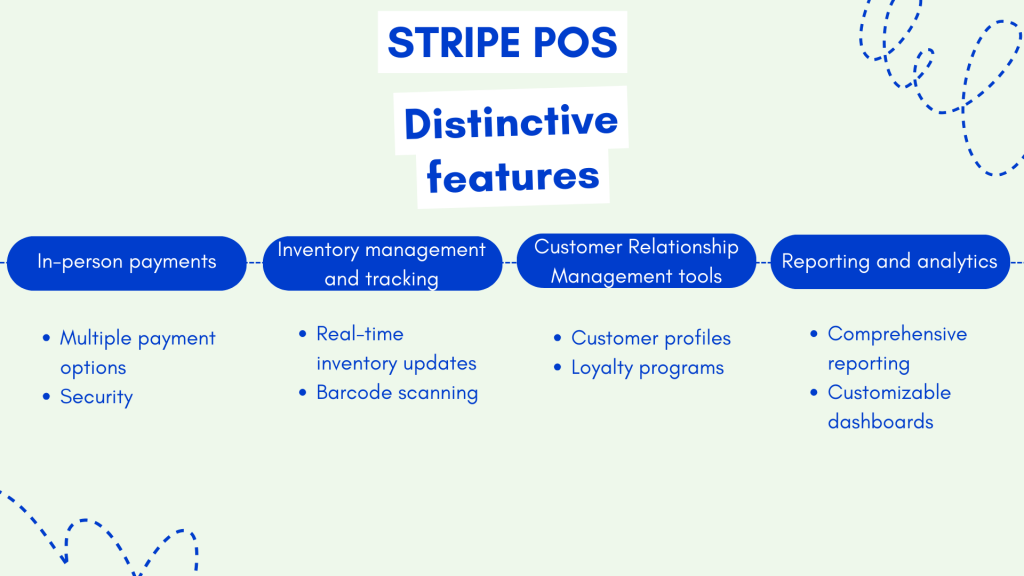When you’re into ecommerce, staying ahead of the curve is crucial. One area where this is particularly evident is in the way payments are handled. The days of cash registers and manual transactions are long gone, and instead, businesses are turning to advanced Point of Sale (POS) systems to streamline their operations and enhance the customer experience.
Stripe, a leading player in the payments industry, has taken this concept to the next level with its Stripe POS software, now known as Stripe Terminal. In this article, we will look at Stripe Terminal, explore its features, benefits for businesses, customization options, security measures, and more.
Understanding Stripe Terminal
Before we dive into the specifics of Stripe Terminal, let’s recall, real quick, what Stripe is and its position in the financial technology landscape.
Stripe is a renowned payment processing company that has earned its reputation for offering secure and efficient payment solutions to businesses. Founded in 2010 by Irish entrepreneurs Patrick and John Collison, Stripe quickly rose to prominence as an online payment gateway. Over the years, it has evolved to become a comprehensive payments platform, offering a wide array of tools and services for businesses to manage their payments seamlessly.
One of Stripe’s standout offerings is its POS system, now known as Stripe Terminal. Stripe Terminal is designed to provide businesses with a complete solution for handling in-person payments, inventory management, customer relationship management (CRM), reporting, and analytics. This transformation from a purely online payment gateway to a versatile POS system has positioned Stripe as a significant player in the world of brick-and-mortar retail as well.
The transformative power of a POS system
If you look at a POS system as a mere cash registers, you can’t be wrong more. Today, POS systems are becoming the cornerstone of efficient and customer-centric operations, being instrumental in shaping the success of businesses across various industries. Let’s dive deeper into the how POS systems power modern businesses.
The central hub of operations
POS systems have emerged as the central hub of operations for businesses of all sizes and types. Whether you’re managing a quaint boutique, a bustling restaurant, or a sprawling retail chain, the POS system serves as the epicenter of your day-to-day activities. At its core, a POS system enables the processing of transactions, but its functionality extends far beyond the confines of a cash register.
Transaction processing
The fundamental purpose of a POS system remains the same: to facilitate seamless transactions between customers and businesses. It allows for secure payment processing, accommodating various payment methods such as credit cards, mobile wallets, and even cryptocurrencies. This capability ensures that transactions are not only convenient for customers but also secure, safeguarding sensitive financial information.
Inventory management
Effective inventory management is crucial for any retail business. A modern POS system provides real-time insights into inventory levels, helping businesses optimize stock levels, prevent overstocking or understocking, and reduce the likelihood of out-of-stock situations. This feature is especially valuable in industries with perishable goods or fluctuating demand.
Customer Data Management
In the age of data-driven decision-making, POS systems are pivotal in managing and leveraging customer data. These systems capture valuable information such as purchase history, preferences, and contact details. With this data, businesses can personalize marketing efforts, create loyalty programs, and enhance the overall customer experience.
The expanding role of POS systems
Today’s POS systems have expanded their role beyond transaction processing and inventory management. They have become powerful tools that empower businesses to thrive in a competitive marketplace.
Seamless shopping experience
Customers expect a seamless and efficient shopping experience, and POS systems play a pivotal role in meeting these expectations. With features like contactless payments, mobile ordering, and self-checkout options, businesses can cater to the evolving preferences of their customers. This not only enhances customer satisfaction but also increases operational efficiency.
Informed decision-making
Informed decision-making is the cornerstone of sustainable business growth. Modern POS systems provide valuable insights into sales trends, customer behavior, and inventory turnover rates. By analyzing this data, businesses can make data-driven decisions, optimize pricing strategies, and identify opportunities for expansion or diversification.
Competitive advantage
POS systems give businesses the tools they need to stay ahead of the competition. Features like loyalty program integration, gift card management, and advanced reporting capabilities enable businesses to differentiate themselves and retain customer loyalty.
The consequences of an inadequate POS system
Businesses that fail to adopt a robust POS system may face a myriad of challenges that can hinder their growth and profitability. These challenges include:
Manual record-keeping
Relying on manual record-keeping processes is not only time-consuming but also prone to errors. Inaccurate records can lead to discrepancies in inventory levels, financial reporting, and customer transactions.
Inefficient inventory management
Inefficient inventory management can result in overstocking or understocking of products, leading to financial losses and missed sales opportunities. Without real-time visibility into inventory, businesses may struggle to meet customer demand.
Longer checkout times
Customers today value speed and efficiency during the checkout process. Without a modern POS system, businesses may experience longer checkout times, which can frustrate customers and negatively impact their shopping experience.
Dissatisfied customers
Ultimately, the consequences of inadequate POS systems can lead to dissatisfied customers. Whether it’s due to errors in transactions, inventory issues, or slow service, dissatisfied customers are more likely to take their business elsewhere.
Integration into a business’s strategy
To fully harness the potential of a POS system, it must seamlessly integrate into a company’s broader business strategy. This integration ensures that every payment becomes a valuable touchpoint in the customer journey, contributing to brand loyalty and long-term customer relationships. Moreover, it empowers businesses to gather data and insights that can be used to optimize operations and drive growth.
Stripe Terminal Features
Now that we have a clear understanding of Stripe and the importance of POS systems, let’s take at Stripe Terminal and see why it might be a standout choice for businesses.
Stripe Terminal is a versatile platform designed to bridge the gap between online and offline transactions for businesses. It empowers businesses to seamlessly accept payments in physical locations, like retail stores and pop-up shops. This is made possible through the integration of various hardware devices such as card readers, barcode scanners, and receipt printers, enabling a cohesive and efficient payment process. Stripe Terminal ensures a unified payment experience by allowing businesses to manage both online and in-person transactions from a single Stripe account, streamlining their financial operations.
Furthermore, Stripe Terminal offers a developer-friendly approach, providing APIs and SDKs for easy integration into custom applications or point-of-sale (POS) systems. Businesses can tailor the payment experience to align with their branding, fostering a consistent and personalized interaction with customers. Additionally, it prioritizes security by adhering to industry standards like PCI compliance to safeguard payment data. Whether a startup or an enterprise, Stripe Terminal caters to businesses of all sizes, offering scalability to meet their evolving needs. Ultimately, it simplifies the process of accepting in-person payments, enabling businesses to manage omnichannel sales effectively and provide a seamless payment experience for their clientele, whether they are online or in-store.
Now, let’s break down its most prominent features.

In-person payments
One of the core functions of any POS system is processing payments efficiently and securely. Stripe Terminal excels in this area:
- Multiple payment options
Stripe Terminal supports a wide range of payment methods, including credit and debit card payments, mobile wallets like Apple Pay and Google Wallet, and even contactless payments. This flexibility ensures that businesses can cater to diverse customer preferences. - Security
Stripe is known for its robust security measures, and this extends to Stripe Terminal. Transactions processed through Stripe Terminal benefit from encryption and compliance with industry standards, reducing the risk of data breaches and fraud.
Inventory management and tracking
Effective inventory management is crucial for businesses in the retail industry. Stripe Terminal offers powerful tools for keeping track of inventory:
- Real-time inventory updates
With Stripe Terminal, businesses can track inventory levels in real-time. This feature helps prevent stockouts and overstocking, allowing businesses to optimize their supply chain. - Barcode scanning
Stripe Terminal supports barcode scanning, making it easy to update inventory records and quickly ring up products at the checkout counter.
Customer Relationship Management (CRM) tools
Building and maintaining strong customer relationships is essential for business success. Stripe Terminal provides CRM tools to help businesses do just that:
- Customer profiles
Businesses can create customer profiles within Stripe Terminal, storing valuable information such as purchase history, contact details, and preferences. This enables personalized interactions and targeted marketing efforts. - Loyalty programs
Stripe Terminal allows businesses to set up and manage loyalty programs, encouraging repeat business and fostering customer loyalty.
Reporting and analytics for insights
Data-driven decision-making is a hallmark of successful businesses, and Stripe Terminal doesn’t disappoint:
- Comprehensive reporting
Stripe Terminal offers detailed reporting and analytics tools that provide insights into sales trends, customer behavior, and more. Businesses can use these insights to make informed decisions and adjust their strategies accordingly. - Customizable dashboards
Users can customize their dashboards to display the metrics that matter most to them, ensuring that they have quick access to the information they need. Basically, Stripe Terminal doesn’t work as a completely advanced POS, so you can look for your Stripe POS alternatives.
What are the benefits for a business?
As you can see, Stripe Terminal offers a pretty extensive feature set that benefits businesses in so many ways: from faster checkouts to enhanced security. It provides valuable transaction insights for informed decision-making and improved customer experiences. It’s flexible, supporting multiple payment methods and scaling with business growth. It also allows for customization and integration, from developer-friendly APIs to branded payment experiences, making it a valuable asset for diverse industries.
Let’s break look at it in more detail.
Streamlined operations
Stripe Terminal streamlines operations in several ways:
- Faster checkout processes
Stripe Terminal’s support for contactless payments goes beyond just speed; it also enhances security. Contactless payments utilize near-field communication (NFC) technology, allowing customers to complete transactions swiftly by simply tapping their cards or mobile devices on the terminal. This not only reduces checkout times but also minimizes the need for physical contact, a feature particularly appreciated during times of health concerns. Efficient barcode scanning is another crucial aspect. Businesses can scan product barcodes with ease, eliminating the need for manual entry and reducing errors. This efficiency results in shorter queues, happier customers, and increased sales. - Inventory optimization
Real-time inventory updates provided by Stripe Terminal have a substantial impact on inventory management. This feature ensures that businesses always have accurate insights into their stock levels. When an item is sold, it’s immediately reflected in the inventory, preventing stockouts. Likewise, businesses are alerted when it’s time to reorder to avoid overstocking. By optimizing inventory in this manner, businesses can allocate resources more effectively, reduce carrying costs associated with excess inventory, and ultimately improve their bottom line.
Enhanced customer experience
The integration of customer data for personalized service and the use of Stripe Terminal for efficient returns and exchanges represent two essential strategies that modern businesses employ to enhance the overall customer experience, being a key to retaining customers. These approaches not only foster customer loyalty but also contribute to long-term business success in today’s competitive marketplace.
Personalized service
Access to customer profiles and purchase history has become a game-changer for businesses in the digital age. This valuable data allows companies to not only understand their customers better but also offer them highly personalized experiences. By analyzing past purchase behavior and preferences, businesses can tailor their offerings to individual customers, making their shopping experiences more enjoyable and convenient.
Imagine a scenario where a customer visits an online clothing store. Thanks to the data stored in their customer profile, the website greets them by name and displays a curated selection of products based on their previous purchases and browsing history. This personalized touch not only saves the customer time but also makes them feel valued. Moreover, by recommending complementary products or offering exclusive discounts on items the customer has shown interest in, businesses can boost their sales and enhance customer loyalty.
Efficient returns and exchanges
Returns and exchanges are an inevitable part of retail, and how a business handles them can significantly impact the customer experience. Stripe Terminal streamlines this process, ensuring that customers enjoy a hassle-free experience even when dealing with product issues.
Consider a scenario where a customer receives a defective product from an online retailer. With Stripe Terminal in place, the customer can initiate a return or exchange with just a few clicks. The system not only generates a prepaid return shipping label but also provides clear instructions on how to package the item. This level of convenience saves the customer time and frustration, making them more likely to return to the same retailer for future purchases.
Furthermore, Stripe Terminal’s efficiency in handling returns and exchanges benefits the business as well. It allows companies to track and manage return patterns, identify product quality issues, and make necessary improvements. By promptly addressing customer concerns and ensuring a seamless return process, businesses can maintain a positive brand reputation and customer loyalty, even in the face of occasional product issues.
Cost savings and improved efficiency
Stripe Terminal’s automation and data-driven capabilities not only reduce manual labor but also empower businesses to make smarter decisions across various facets of their operations. This transformative technology enhances efficiency, customer satisfaction, and profitability, positioning companies for sustainable growth in today’s competitive business landscape.
Let’s look at those at different angles.
Reduced manual labor
The implementation of Stripe Terminal’s payment processing and inventory management automation goes far beyond just streamlining tasks; it fundamentally transforms the way businesses operate. By automating payment processing, companies can significantly reduce the reliance on manual labor, a critical benefit that affects various aspects of their operations.
- Processing payments
Traditionally, businesses had to rely on manual card swipes or cash handling, which not only introduced the risk of errors but also consumed valuable time that could be better spent on other activities. With Stripe Terminal, transactions are seamlessly processed, whether in-store or remotely, through secure and efficient electronic payment methods. This reduces the need for staff to perform repetitive, time-consuming tasks like manually entering payment details, tallying cash, or reconciling transactions. - Managing inventory
Managing inventory is a labor-intensive task that can quickly become overwhelming, especially for businesses with a wide range of products and high sales volumes. Stripe Terminal’s automation capabilities extend to inventory management, where real-time tracking of stock levels, automatic updates, and alerts for low stock items help eliminate the need for manual stock counts and reorder calculations. This not only saves time but also reduces the likelihood of stockouts or overstocking, optimizing overall inventory management efficiency. - Shifting to value-added tasks
With the reduction in manual labor requirements for payment processing and inventory management, staff members can be redirected to more valuable and strategic tasks. This shift empowers employees to focus on customer service, sales, marketing, and other activities that drive business growth and enhance the overall customer experience. Employees can engage in tasks that require creativity, problem-solving, and human interaction, contributing to a more satisfying work environment and ultimately improving customer satisfaction.
Data-driven decision-making
Stripe Terminal’s suite of reporting and analytics tools plays a pivotal role in helping businesses harness the power of data to make informed decisions. This data-driven approach influences various aspects of a company’s strategy and operations.
- Sales insights
Stripe Terminal provides detailed reports on sales performance, allowing businesses to identify trends, peak sales periods, and the popularity of specific products or services. Armed with this information, companies can optimize pricing, promotions, and product offerings to maximize revenue. For instance, a business may choose to run promotions during peak sales periods or adjust its inventory to cater to customer preferences. - Inventory optimization
The data-driven insights also extend to inventory management. Companies can analyze sales data to determine which items are selling well and which are lagging. This information guides decisions on reordering, discontinuing slow-moving products, and making adjustments to the overall product mix. The result is a leaner inventory that minimizes carrying costs and maximizes profitability. - Customer engagement
Understanding customer behavior and preferences is crucial for building lasting relationships. Stripe Terminal’s analytics tools enable businesses to delve into customer data, identifying their preferences, purchase history, and demographic information. Armed with this knowledge, companies can tailor marketing campaigns, loyalty programs, and customer interactions to better serve their clientele, ultimately leading to increased customer retention and loyalty. - Cost savings
By making data-driven decisions informed by Stripe Terminal’s insights, businesses can identify areas where cost savings are possible. This could involve optimizing staffing levels during slower periods, renegotiating supplier contracts based on sales data, or pinpointing operational inefficiencies that can be addressed. The result is a more cost-effective operation that contributes directly to the company’s bottom line.
POS software: customization and scalability
Stripe Terminal offers businesses the freedom to customize their payment systems and the scalability to grow with confidence. Whether you’re a startup aiming to establish your presence or a well-established enterprise seeking to streamline your payment processes, Stripe Terminal provides the tailored solutions and scalability required to meet your evolving needs in the dynamic world of commerce.
Tailored solutions
Stripe Terminal offers businesses a high degree of flexibility and customization. It recognizes that every business is unique and has distinct requirements when it comes to payment processing. With Stripe Terminal, businesses can tailor their payment systems to precisely match their needs. This customization extends to various aspects of the payment process, inventory management, and even customer relationship management (CRM).
For example, businesses can seamlessly integrate Stripe Terminal into their existing checkout process, ensuring a smooth and branded payment experience for their customers. This customization allows them to design a payment flow that aligns with their brand identity and user experience. Moreover, Stripe Terminal’s inventory management capabilities enable businesses to efficiently track and manage their stock levels, ensuring they never run out of products and can meet customer demand effectively.
In addition, the CRM features offered by Stripe Terminal empower businesses to nurture customer relationships and enhance customer loyalty. Companies can gather valuable data about their customers’ purchasing behavior, preferences, and history, enabling them to create targeted marketing campaigns and personalized promotions. This level of customization and adaptability makes Stripe Terminal an invaluable tool for businesses in various industries.
Scalability
One of the key advantages of Stripe Terminal is its scalability. It caters to businesses of all sizes, from small startups looking to establish their online presence to large enterprises with complex payment processing needs. As a business grows, its requirements evolve, and Stripe Terminal is designed to seamlessly scale alongside it.
- For startups and small businesses, Stripe Terminal offers an accessible and user-friendly platform to kickstart their online or brick-and-mortar sales operations. These businesses can start with a basic setup and then expand their payment processing capabilities as they attract more customers and generate more revenue.
- Large enterprises, on the other hand, benefit from Stripe Terminal’s ability to handle high volumes of transactions, complex payment processing workflows, and the integration of advanced CRM features. As businesses reach higher levels of growth and complexity, Stripe Terminal’s robust infrastructure ensures that they have the tools and resources they need to manage their payments efficiently.
Stripe Terminal’s scalability is not limited to the size of a business. It also accommodates changes in transaction volume, seasonal fluctuations, and emerging market trends. This adaptability allows businesses to respond to market dynamics and seize new opportunities without the need for significant overhauls or system replacements.
Payments security and compliance
Stripe invests a substantial effort in providing a secure and trustworthy payment processing solution. Their layers of security not only protect sensitive data but also instill confidence in businesses and their customers, making it a valuable tool in today’s digital payment landscape.
Encryption
When it comes to safeguarding sensitive payment data, encryption stands as the bedrock of security within Stripe Terminal. Every transaction passing through this platform undergoes robust encryption processes, providing multiple layers of protection against potential threats. The encryption employed here is state-of-the-art, ensuring that customer payment information is shielded from any prying eyes or malicious actors.
Stripe Terminal employs strong cryptographic techniques to transform payment data into an unreadable format while in transit. This is done using secure protocols and algorithms, rendering the data virtually useless to anyone who may intercept it. Only authorized parties with the appropriate decryption keys can unlock and access the information. This level of encryption ensures that confidential data remains confidential throughout the entire transaction process.
PCI compliance
Payment Card Industry Data Security Standard (PCI DSS) compliance is paramount in the world of payment processing, and Stripe Terminal takes this responsibility seriously. The platform adheres to the strictest PCI DSS requirements, ensuring that all sensitive cardholder information is handled and stored in a secure and compliant manner.
Achieving PCI compliance is a complex and ongoing process that requires meticulous attention to detail. Stripe Terminal not only meets these standards but also stays up to date with any changes or updates to PCI DSS. This compliance provides not only peace of mind but also a competitive edge for businesses, assuring both them and their customers that payment data is treated with the utmost care and protection.
Fraud detection
In addition to robust encryption and PCI compliance, Stripe Terminal employs advanced fraud detection mechanisms to bolster security further. These mechanisms are designed to detect and prevent fraudulent transactions, minimizing the risk of financial loss and reputational damage to businesses.
The fraud detection system is powered by machine learning algorithms and real-time monitoring. It continuously analyzes transaction data for patterns and anomalies that may indicate fraudulent activity. Suspicious transactions are flagged for review, allowing for swift action to be taken. This proactive approach helps protect both businesses and their customers from the potentially devastating consequences of fraud.
It’s worth mentioning that Stripe Terminal’s fraud detection system is not static; it evolves and adapts to emerging threats. By learning from past incidents and staying ahead of new fraud tactics, it remains a formidable defense against increasingly sophisticated fraudulent activities.
User-friendly interface
Stripe Terminal has gained widespread acclaim for its user-friendly interface, meticulously crafted to cater to the needs of both staff and customers alike. It is an indispensable tool for businesses seeking to streamline their checkout process, ensuring that every transaction is smooth and hassle-free.
- Customer-centric design
At the forefront of Stripe Terminal’s design philosophy is the customer experience. The interface is carefully crafted to be intuitive, visually appealing, and responsive, creating an inviting environment for customers during the checkout process. Buttons are strategically placed, and the overall layout is designed to minimize confusion and maximize ease of use. This customer-centric approach translates into higher satisfaction rates, repeat business, and positive reviews. - Staff training made effortless
One of the standout features of Stripe Terminal is its minimal training requirement for staff. Traditional point-of-sale (POS) systems often necessitate extensive training sessions, which can be time-consuming and costly. However, with Stripe Terminal, the learning curve is remarkably gentle. Staff members can quickly grasp the system’s ins and outs, thanks to its intuitive design and straightforward navigation. - Reduced training costs
For businesses, the reduced need for extensive training translates into substantial cost savings. With Stripe Terminal, the time and resources previously allocated to training sessions can be redirected towards other critical areas of operation. Moreover, businesses can onboard new staff members more swiftly, ensuring that they can contribute to the company’s success sooner rather than later. - Efficiency at its core
Stripe Terminal is more than just easy to learn; it’s built for efficiency. The streamlined interface allows staff to process transactions rapidly, minimizing wait times for customers. Cashiers can effortlessly scan barcodes, input item quantities, and accept a variety of payment methods, from credit and debit cards to mobile wallets. This efficiency not only enhances the overall shopping experience but also enables businesses to serve more customers during peak hours, ultimately boosting revenue. - Adaptability and customization
Stripe Terminal’s ease of use isn’t one-size-fits-all. It offers customization options, allowing businesses to tailor the interface to match their specific needs and branding. Whether it’s adjusting the color scheme, adding a logo, or incorporating unique promotional offers, Stripe Terminal adapts to align with the business’s identity, fostering a sense of continuity for customers.
Integration and ecosystem
Stripe Terminal’s seamless integrations and connected ecosystem empower businesses to streamline their operations, enhance the customer experience, and optimize their financial processes. This versatility makes it a valuable tool for businesses looking to thrive in an increasingly digital and competitive landscape.
Seamless integrations
Stripe Terminal is renowned for its ability to effortlessly integrate with a diverse array of software applications, making it an incredibly versatile solution for businesses of all sizes and industries. Its versatility extends to various aspects of business operations, enabling companies to streamline their payment processing and operational workflows.
- E-commerce Platforms: For businesses with online storefronts, Stripe Terminal seamlessly integrates with popular e-commerce platforms like Shopify, WooCommerce, Magento, and BigCommerce. This integration enables merchants to accept in-person payments through Stripe Terminal while also managing their online sales from a single, unified dashboard. It ensures consistency in inventory management, pricing, and customer data across both physical and digital sales channels.
- Accounting Software: Stripe Terminal offers native integrations with leading accounting software systems such as QuickBooks, Xero, and FreshBooks. These integrations enable automatic synchronization of transaction data, reducing the manual effort required for reconciling financial records. This ensures that financial reporting is accurate and up-to-date, helping businesses maintain compliance and make informed financial decisions.
- Customer Management Systems: Managing customer relationships is essential for businesses seeking to provide exceptional service and build loyalty. Stripe Terminal can integrate with customer relationship management (CRM) systems such as Salesforce, HubSpot, and Zoho CRM. This integration facilitates the seamless exchange of payment data and customer information between the point of sale and the CRM, empowering businesses to offer personalized experiences and targeted marketing efforts.
Connected ecosystem
Stripe Terminal’s integrated ecosystem offers a holistic solution for businesses, seamlessly uniting various tools and functions. It handles diverse payment methods across different channels, streamlines inventory management, provides robust analytics for data-driven decisions, enhances operational efficiency through accounting software integration, and optimizes customer experiences, fostering loyalty and retention.
Conclusion
In today’s dynamic retail landscape, businesses need more than just a payment processing solution; they need a comprehensive POS system that can streamline operations, enhance the customer experience, and provide valuable insights for growth. Stripe Terminal, born out of Stripe’s expertise in online payments, has evolved into a versatile and powerful POS system that caters to the diverse needs of businesses, both online and offline. With its features, customization options, security measures, and user-friendly interface, Stripe Terminal is poised to revolutionize the way businesses handle payments and operations, setting them on a path to success in the ever-evolving world of commerce.






